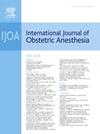开发基于收缩的疼痛指数(CONPAIN)来评估分娩硬膜外镇痛的有效性:一项试点概念验证研究
IF 2.3
3区 医学
Q2 ANESTHESIOLOGY
引用次数: 0
摘要
分娩疼痛评估对指导神经轴镇痛至关重要,但目前的工具,如数字评定量表(NRS)受到主观可变性的影响。我们开发并测试了收缩疼痛指数(CONPAIN),以自我报告的疼痛持续时间与外部心脏摄影测量的收缩持续时间的百分比计算。我们假设在给药后的前10分钟,CONPAIN会比NRS显示较基线较早的相对变化。方法在这项探索性、单中心的试点研究中,记录27例主动分娩的产妇在硬膜外镇痛开始前后的CONPAIN和NRS。数据收集开始于初次硬膜外注射前5分钟,此后持续20分钟。主要终点是CONPAIN相对于基线的时间趋势;次要结局是比较CONPAIN和NRS从基线的百分比变化及其随时间的相关性。结果两项指标在前五分钟内均下降。0-5分钟时,CONPAIN组的中位百分比变化为- 27.96%,而NRS组为- 7.14% (P < 0.001);在6 - 10分钟,与−−48.99% 40.00% (P = 0.027)。10分钟后差异不显著。结论:在这项概念验证研究中,与NRS相比,在分娩镇痛开始后的前10分钟,CONPAIN表现出更大的相对变化,这表明在描述镇痛反应的早期动态方面具有潜在价值。虽然这些发现为其临床相关性提供了初步支持,但需要在更大的人群中进行验证。本文章由计算机程序翻译,如有差异,请以英文原文为准。
Development of a contraction-based pain index (CONPAIN) to evaluate labor epidural analgesia effectiveness: a pilot proof-of-concept study
Background
Assessment of labour pain is essential to guide neuraxial analgesia, yet current tools such as the Numeric Rating Scale (NRS) are influenced by subjective variability. We developed and tested the Contraction Pain Index (CONPAIN), calculated as the percentage ratio of self-reported pain duration to contraction duration measured on external cardiotocography. We hypothesised that CONPAIN would show an early relative change from baseline than NRS in the first 10 minutes after dosing.
Methods
In this exploratory, single-center pilot study, CONPAIN and NRS were recorded in 27 nulliparous women in active labor before and after initiation of epidural analgesia. Data collection started five minutes before the initial epidural bolus and continued for 20 min thereafter. The primary outcome was the temporal trend of CONPAIN relative to baseline; secondary outcome was the comparison of percentage change from baseline between CONPAIN and NRS and their correlation over time.
Results
Both metrics decreased within the first five minutes. Median percentage change at 0–5 minutes was −27.96 % for CONPAIN vs. −7.14 % for NRS (P < 0.001); at 6–10 minutes, −48.99 % vs. −40.00 % (P = 0.027). Differences were not significant after 10 minutes.
Conclusions
In this proof-of-concept study, CONPAIN showed greater relative changes compared to NRS during the first 10 minutes following initiation of labour analgesia, suggesting potential value in characterising the early dynamics of analgesic response. While these findings offer preliminary support for its clinical relevance, validation in larger populations is required.
求助全文
通过发布文献求助,成功后即可免费获取论文全文。
去求助
来源期刊
CiteScore
4.70
自引率
7.10%
发文量
285
审稿时长
58 days
期刊介绍:
The International Journal of Obstetric Anesthesia is the only journal publishing original articles devoted exclusively to obstetric anesthesia and bringing together all three of its principal components; anesthesia care for operative delivery and the perioperative period, pain relief in labour and care of the critically ill obstetric patient.
• Original research (both clinical and laboratory), short reports and case reports will be considered.
• The journal also publishes invited review articles and debates on topical and controversial subjects in the area of obstetric anesthesia.
• Articles on related topics such as perinatal physiology and pharmacology and all subjects of importance to obstetric anaesthetists/anesthesiologists are also welcome.
The journal is peer-reviewed by international experts. Scholarship is stressed to include the focus on discovery, application of knowledge across fields, and informing the medical community. Through the peer-review process, we hope to attest to the quality of scholarships and guide the Journal to extend and transform knowledge in this important and expanding area.

 求助内容:
求助内容: 应助结果提醒方式:
应助结果提醒方式:


